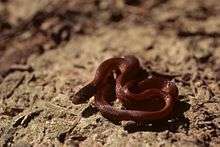Pine woods snake
| pine woods snake | |
|---|---|
 | |
| Scientific classification | |
| Kingdom: | Animalia |
| Phylum: | Chordata |
| Subphylum: | Vertebrata |
| Class: | Reptilia |
| Order: | Squamata |
| Suborder: | Serpentes |
| Family: | Colubridae |
| Subfamily: | Colubrinae |
| Genus: | Rhadinaea |
| Species: | R. flavilata |
| Binomial name | |
| Rhadinaea flavilata (Cope, 1871) | |
| Synonyms | |
The pine woods snake (Rhadinaea flavilata), also commonly known as the yellow-lipped snake or the brown-headed snake,[4] is a species of secretive colubrid found in scattered locations across the Southeastern United States. Rhadinaea flavilata is rear-fanged and mildly-venomous, but not usually dangerous to humans.[5]

Description
R. flavilata is a small reddish brown to yellowish brown snake with a whitish to yellowish, unmarked underside. A dark stripe runs through the eye. The upper labial scales (lip scales) are a whitish or pale yellow color which led to its other common name, the yellow-lipped snake.[6]
Pine woods snakes average between 10 and 13 inches (25–33 cm) in total length (including tail) at adult size.[7]
Geographic range
The pine woods snake is known from scattered localities in coastal North Carolina and South Carolina, most of peninsular Florida, and small portions of Georgia, Alabama, and Louisiana.
Habitat
Pine woods snakes are found in damp woodlands, under bark and in rotten logs and stumps.[7]
Diet
R. flavilata feed on small frogs and lizards.[7]
Reproduction
Pine woods snakes lay eggs.[8]
References
- ↑ Boulenger GA. 1894. Catalogue of the Snakes in the British Museum (Natural History). Volume II., Containing the Conclusion of the Colubridæ Aglyphæ. London: Trustees of the British Museum (Natural History). (Taylor and Francis, printers). xi + 382 pp. + Plates I-XX. (Liophis flavilatus, p. 143).
- ↑ Stejneger L, Barbour T. 1917. A Check List of North American Amphibians and Reptiles. Cambridge, Massachusetts: Harvard University Press. 125 pp. (Leimadophis flavilatus, pp. 86-87).
- ↑ "Rhadinaea flavilata ". The Reptile Database. www.reptile-database.org.
- ↑ Wright AH, Wright AA. 1957. Handbook of Snakes of the United States and Canada. Ithaca and London: Comstock Publishing Associates. 1,105 pp. (in 2 volumes). (Rhadinaea flavilata, pp. 627-631, Figure 182, Map 47).
- ↑ Smith HM, Brodie ED Jr. 1982. Reptiles of North America: A Guide to Field Identification. New York: Golden Press. 240 pp. ISBN 0-307-13666-3. ("Front-grooved, rear-fanged group", Rhadinaea flavilata, pp. 176-177).
- ↑ Behler JL, King FW. 1979. The Audubon Society Field Guide to North American Reptiles and Amphibians. New York: Alfred A. Knopf. 743 pp. ISBN 0-394-50824-6. (Rhadinaea flavilata, pp. 648-649 + Plates 462, 465).
- 1 2 3 Conant R. 1975. A Field Guide to Reptiles and Amphibians of Eastern and Central North America, Second Edition. Boston: Houghton Mifflin. xviii + 429 pp. + Plates 1-48. ISBN 0-395-19979-4 (hardcover), ISBN 0-395-19977-8 (paperback). (Rhadinaea flavilata, pp. 175-176 + Plate 25 + Map126).
- ↑ Schmidt KP, Davis DD. 1941. Field Book of Snakes of the United States and Canada. New York: G.P. Putnam's Sons. 365 pp. (Rhadinaea flavilata pp. 113-114, Figure 24 + Plate 9).
Further reading
- Conant R, Bridges W. 1939. What Snake is That?: A Field Guide to the Snakes of the United States East of the Rocky Mountains. (with 108 drawings by Edmond Malnate). New York and London: D. Appleton-Century. Frontispiece map + 163 pp. + Plates A-C, 1-32. (Rhadinaea flavilata, p. 70 + Plate C, Figure 11).
- Cope ED. 1871. Ninth Contribution to the Herpetology of Tropical America. Proc. Acad. Nat. Sci. Philadelphia 23 (2): 200-224. (Dromicus flavilatus, new species, pp. 222–223).
- Malnate E. 1939. A Study of the Yellow-Lipped Snake, Rhadinaea flavilata (Cope). Zoologica 24: 359-366 + one plate.
- Zim HS, Smith HM. 1956. Reptiles and Amphibians: A Guide to Familiar American Species: A Golden Nature Guide. New York: Simon and Schuster.160 pp. (Rhadinaea flavilata, pp. 83–84, 156).